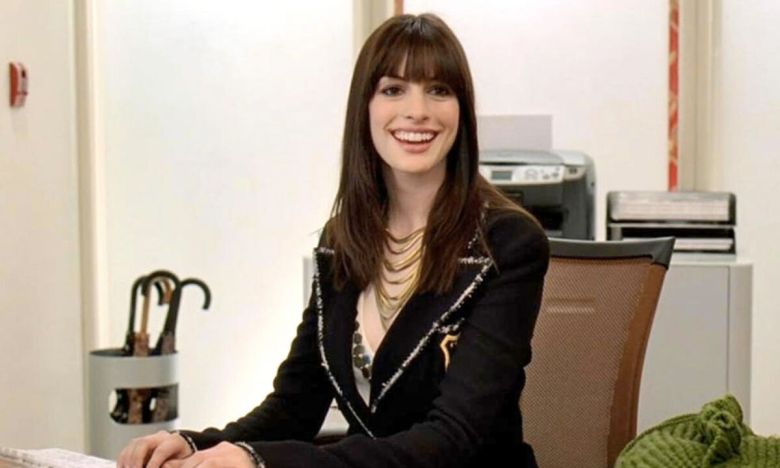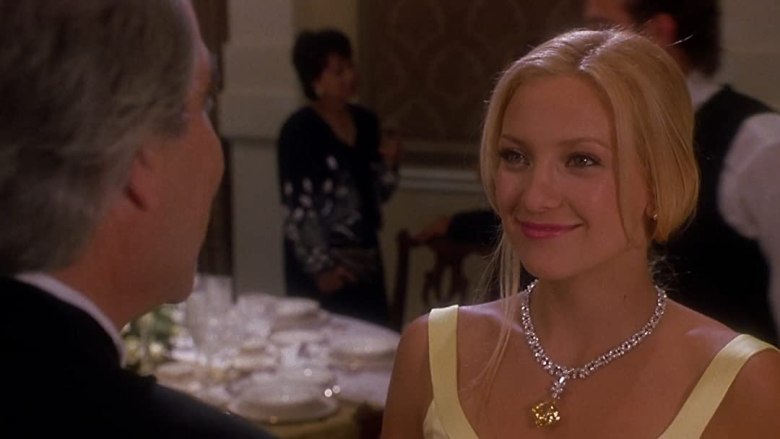By providing your information, you agree to our Terms of Use and our Privacy Policy. We use vendors that may also process your information to help provide our services. This site is protected by reCAPTCHA Enterprise and the Google Privacy Policy and Terms of Service apply.
‘How to Lose a Guy in 10 Days’ Revolutionized Rom-Coms — and Inspired a Wave of Female Journalists

Samantha Bergeson

The premise was simple enough: A no-nonsense, non-conformist, feminine “guy’s girl” journalist sets out to make a man fall in love with her — all for the sake of a big break at work. When “How to Lose a Guy in 10 Days” hit theaters on February 7, 2003, the Kate Hudson– and Matthew McConaughey-starring romantic comedy ushered in a new generation of a revived rom-com sub-genre: quippy romances all about female journalists.
In the Donald Petrie film, Andie Anderson (Hudson) half-jokingly pitches the idea of using all the “what not to do” tips of Composure, the Cosmo-esque fastest growing women’s magazine she works at, to prove the opposite: being disinterested and not clingy works better to land a husband, or better yet, find true love. Kathryn Hahn is her unlucky-in-love coworker whose exploits inspire Andie’s approach to a new lifestyle feature article, while Bebe Neuwirth is her ice-cold editor whose likeness appears in everything from “The Bold Type” to “The Devil Wears Prada.” But we’ll get to that later.
Andie soon crosses paths with Benjamin Barry (Matthew McConaughey) — because what is a rom-com without consecutive alphabet alliterations in names? — and Ben is challenged by his own marketing colleagues to make a woman fall in love with him in (you guessed it!) 10 days to land a major luxury diamond jewelers account. “How to Lose a Guy in 10 Days” confirmed McConaughey and Hudson as the new Tom Hanks and Meg Ryan rom-com duo, launched a search for canary-colored slip dresses everywhere, and made journalism seem like a glossy yet respectable career.
Getting paid to dupe a man in the name of research? Sounds like heaven, complete with a killer wardrobe, colleagues who are more like friends, and the aspiration (and ever-present option) to cover more substantial stories.

“How to Lose a Guy in 10 Days” is far from the first female journalist rom-com. It harkens back to films “His Girl Friday” (1940), “Christmas in Connecticut” (1945), “Broadcast News” (1987), “Sleepless in Seattle” (1993, which is also referenced in the film), “Never Been Kissed” (1999), and “Brown Sugar” (2002). These films center on either sparks flying with like-minded colleagues or undercover operations proving a new love interest for the leading woman.
Even “My Best Friend’s Wedding” (1997) had Julia Roberts playing a food critic, while Sally (Meg Ryan) in “When Harry Met Sally” (1989) worked for New York Magazine. And no one can forget TV series “Sex and the City” which gave its own twist on the plights of female columnists.
But each iteration of that character trope — the hardworking yet fun reluctant “it” girl whose career is truly a lifestyle — was embodied and expanded upon the most in early 2000s romantic comedies, arguably starting with “How to Lose a Guy in 10 Days.”
“There was a very feminist twist to that movie and it really inspired young girls and that makes me so happy,” Hudson recently said on “The Today Show” (via People). “Now there’s a new generation of journalists who would say ‘Andie Anderson made me want to be a journalist.'”
Co-star Kathryn Hahn added to Vanity Fair, “I think this movie just is joy: beautiful humans and souls, a complicated-enough setup, real female friendships, a woman with ambition and the ache for authenticity. Kate and I just did a junket [for ‘Glass Onion’] and can’t tell you how many journalists said they were inspired by Andie Anderson.”
As Andie ruins boys’ night, cons Ben into attending a Celine Dion concert instead of a Knicks game, yells about a “love fern” being wilted, and throws a hairless dog in Ben’s face, she is the epitome of all unlikable “shrill” traits. But at the heart of it, Andie is still effortlessly cool and approachable even in her mock insanity.
Eventually, Andie even turns endearing. It’s a Staten Island-set game of “Bullshit” with Ben’s family that solidifies the budding true romance between the faux couple, and she eventually wins Ben back after the con is revealed (at a gala ball, no less) by writing in her article that she “lost the only guy I’ve ever fallen for.” Andie later quits Composure and is on her way to Washington D.C. to save the world, and inadvertently win back her man, all through the printed word.
Imagine coming of age when prominent female ideals onscreen were the likes of Jenna Rink in “13 Going on 30” (2004) and Andy Sachs in “The Devil Wears Prada” (2006). At once a corporate celebration of women’s determination to pitch the perfect story and land the gig and, eventually, also the man, the trend was essentially Hollywood rubber-stamping a third wave feminist career path.
Hate rules? Dread the idea of a cubicle? Or, at age 10, just like watching beautiful, independent women with seemingly attainable lives land happily-ever-afters? A female journalist-fronted rom-com answered everything.
“It’s actually quite [a] feminist movie, and I think that really resonates with young girls: The concept that women are in control of their own destiny, their own life, and their own purpose and the fact that Andie is a journalist [who’s] working a job that isn’t really what she wants to be doing, and she chooses to pursue her dream,” Hudson told Vanity Fair in honor of the film’s 20th anniversary. “It’s a very strong female character that a lot of women connect to.”
It was the era of superheroes for wide-eyed (and let’s be real, white and middle class) girls everywhere. The corporate ladder in these respective films also were almost always led by women, with editor-in-chief positions held by Anna Wintour doppelgängers. Magazine journalism was showcased as a safe space to try new experiences for the sake of the story as opposed to stuffy, intense, and crowded newspaper pitch meetings (the spilled coffee, the frumpy men, no thanks.)
Almost parallel to magazine journalism was the on-air producers profession, as showcased in “The Mary Tyler Moore Show” (1970), “Bridget Jones’ Diary” (2001), “Someone Like You” (2001), “The Ugly Truth” (2009), “Morning Glory” (2010), and plenty more. And yet there was something about the women-only newsrooms for magazine journalists that created a special environment onscreen strictly original and empowering.

Films like “Confessions of a Shopaholic” (2009) and “Letters to Juliet” (2010) and series “The Bold Type” (2017) continued the female journalist rom-com sub-genre to varying results in later years. Even “He’s Just Not That Into You” (2009) felt like a direct response to “How to Lose a Guy in 10 Days.” “Girls,” albeit a then-unprecedented twist on the conditioned expectations of female writers, broke new ground upon its debut in 2012. Even “How to Lose a Guy in 10 Days” star McConaughey detailed how the film’s poster was replicated by dozens of rom-com marketing campaigns for years after. The film was, quite simply, the epitome of high concept filmmaking in what is now seemingly a bygone era.
There’s a reason why “How to Lose a Guy in 10 Days,” “13 Going on 30,” and “Devil Wears Prada” are constantly being revisited with sequel ideas. Sure, the fashion, the fame of their respective stars, and the pre-built IP makes them attractive; but it’s the enduring nostalgia that still makes those films relevant in an odd way. They resemble the promise of a foray into capitalism that is an all-encompassing escape from what is perceived as the confines of adulthood. There is a still a fantasy of the possibility of absolutely anything happening at any given moment, so long as you’re open to the idea (or story pitch) of it, including meeting that special someone.
While Anne Hathaway has been sartorially calling back to Andy Sachs from “The Devil Wears Prada,” the Oscar winner shared on “The View” that the film could never be made today. “I just think that movie was in a different era. Now everything’s gone so digital,” Hathaway said. “That movie is centered around the concept of producing a physical thing and it’s just very different.”

Hudson similarly spoke out on how rom-coms have been “dumbed down” in recent years.
“[They need] an actually good story, let’s start with that,” Hudson said during the “Hot Ones” YouTube show. “I think sometimes people think rom-coms are all about the ‘meet cute.’ A great rom-com is about meeting love, discovering love, falling in love, love falling apart, and then how you come back together. That’s a very traditional rom-com structure.”
She continued, “The ones that we love are with two movie stars in a love story. They’re shiny and they’re bright and it’s like wish fulfillment. It’s supposed to make you feel fuzzy, and then they stay with you forever. They’re the most classic. I think the genre gets kind of dumbed down because they think they know. And then the chemistry … so I’m grateful that it was me and Matthew [McConaughey], because he’s a blast.”

Per Zippia, 53.4 percent of all journalists are women, with a majority based in New York City as depicted in the aforementioned respective rom-coms. The statistic has increased by approximately 16 percent since 2001, when the American Society of Newspaper Editors (ASNE) estimated that women were 37 percent of news staffs, according to Nieman Reports in 2002. However, as the A.V. Club included in 2014, journalists only make up 0.067 percent of the total professional population to begin with.
So what are we left with in this “dumbed down” rom-com era, when it comes to aspirational careers onscreen? Well, from event planners to bakers, architects to bookstore owners, the whimsical professions for rom-com ready women are sidelined to Hallmark movies and the occasional blockbuster.
It’s the enduring desire to seek out “wish fulfillment” as “How to Lose a Guy in 10 Days” star Hudson described that unknowingly launched a generation of women who spent the subsequent two decades in pursuit of that ideal lifestyle, brought upon by the ideal career, and of course, the ideal partner.
So would Andie Anderson be working at The Washington Post today, or leading a Goop-like venture? Or, dare we say, a bakery in a small-town that only exists in the golden autumn? It really does feel like the future of rom-coms depends on the answer. Andie, we’re waiting.
By providing your information, you agree to our Terms of Use and our Privacy Policy. We use vendors that may also process your information to help provide our services. This site is protected by reCAPTCHA Enterprise and the Google Privacy Policy and Terms of Service apply.

















